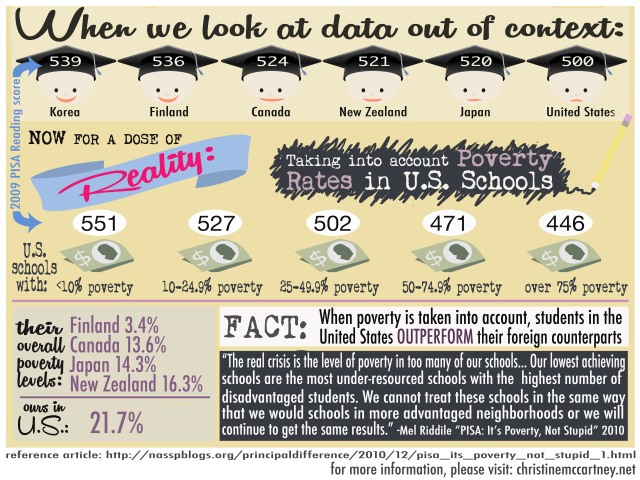I’ve been explaining this to countless Finnish teachers and it has been provoking so many interesting conversations about equity and resources, that I thought I would simplify it into a visual representation. Find the articles that I sourced most of the information from here and here. The question now becomes, “How do we take this information and do something about it?” Mel Riddile (quoted above) would argue that we need to stop looking to countries like Finland because the difference in poverty levels make the results here irreproducible in the States. He suggests we look at schools in the United States that have turned around performance in areas of high economic need. I agree. But now that I have been intricately looking at Finnish schools, I am realizing that there are definitely aspects that can be pulled towards our classrooms in the United States… none of them are the silver bullet that we Americans love to search for, but they are practical changes that teachers and schools can implement…more to come…

Educator of the Week Spotlight

guest blogger at:



Follow me on Twitter
My Tweetsother amazing endeavors:
…
The views and information expressed on this blog are mine and mine alone and do not represent the Department of State or the Fulbright Program. This is not an official Department of State or Fulbright Program website or blog.Most liked posts by an educator’s re-education

spreading the word:
- 73,947 hits


I noticed that the poverty level (in %) of Korea was left out. Any idea why?
Pingback: Can We Talk About Poverty And Violence NOW? | Daniel Katz, Ph.D.
Well, I thought #1 was Shanghai and that we were tied for 34th overall with Vietnam. Are you implying that they have less poverty than we do?
Reblogged this on Ready for the New World and commented:
More about the connection between poverty and education in Finland and the US
Pingback: Poverty, Equity, Social Justice and Education | Joy of Education
I feel the same might be true in Australia. Our schools are widely divergent in the communities that they serve. Some are remote and isolated, some are urbanised with high unemployment. Communities in countries such as Singapore and Finland might be more homogeneous. Worth thinking about.
It is the culture of poverty that is difficult to fight against. The idea that when mommy makes an extra 100 dollars, it will be spent on buying Jimmy new cool sneakers, rather than food to put on the table. I found it disturbing what my “poor” kids had and then at the same time only ate once a day. The focus becomes money and stuff, rather than being successful and finding your passion. I felt completely overwhelmed with trying to help these kids. You are fighting much more than an empty stomach.
You’re right, but then again, it’s way easier to get support for food than for getting stuff – especially in a country like the US where the social programs are charity-driven. This is actually a logical choice – up to a point.
There is absolute poverty and relative poverty and the latter is more detrimental to social cohesion than absolute poverty. Not “having stuff” may actually exclude a person from society. One of the reasons why younger generation is better with technology is because they’ve played with it their whole lives.
Here are a few things about the ‘culture of poverty’ that might help you:
http://whatever.scalzi.com/2005/09/03/being-poor/; http://www.cracked.com/blog/the-5-stupidest-habits-you-develop-growing-up-poor/; http://poorasfolk.com/
Reblogged this on ces domaines soient appartient à Valerie.
Pingback: An important graphic on comparing apples to apples #poverty #capeducation – @ THE CHALK FACE knows SCHOOLS MATTER
These are really great—eye-opening!
Poverty has a snowball effect in so many ways. Children tend to come to school with a diminished vocabulary, which in turn impacts reading and writing. Even though there may be free breakfast and lunch, not all students take advantage of it. If a student’s stomach is growling with hunger, learning takes a back seat. It makes me think of Maslow; if basic needs are not met, students will struggle and may never achieve self-actualization. One has only to look at the beautiful and serene setting in Christine’s pictures to discern that education, teachers, and students are valued..
this post backs up a point I was trying to explain to my highschool students…How we can’t just take a european teaching/education strategy and think it’ll work and give the same results in my poverty striken country-Mexico… thank you, Alexandra
This definitely matches up with my experience teaching in NYC and my high school experience as a student @ NFA back in the day. I’d wager that most of my old classmates in my honors classes lived in the town of Newburgh or New Windsor (although a few lived within the Newburgh city limits). The honors level classes are generally top notch at most American high schools and can match or surpass most nations. But endemic poverty, especially in areas like the city of Newburgh, throws two strikes at these kids before they even step foot in a school in the first place.
I like it and I’ve been thinking about our conversation today. POVERTY!